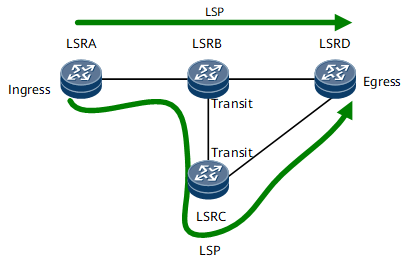LDP Traffic Statistics Collection
If a device functions as the ingress or transit node of an LDP LSP and the primary LDP LSP uses a destination IP address mask of 32 bits, the device collects statistics about primary LDP LSP traffic that an outbound interface forwards. LDP traffic statistics collection enables users to query and monitor LDP LSP traffic in real time.
Implementation
LDP traffic statistics collection enables the ingress or a transit node to collect statistics only about outgoing LDP LSP traffic with the destination IP address mask of 32 bits.
In Figure 1, each pair of adjacent devices establishes an LDP session and LDP LSP over the session. Two LSPs originate from LSRA and are destined for LSRD along the paths LSRA -> LSRB -> LSRD and LSRA -> LSRB -> LSRC -> LSRD. LSRB is used as an example. LSRB functions as either a transit node to forward LSRA-to-LSRD traffic or the ingress to forward LSRB-to-LSRD traffic. LSRB collects statistics about traffic sent by the outbound interface connected to LSRD and outbound interface connected to LSRC. LSRA can only function as the ingress, and therefore, collects statistics about traffic only sent by itself. LSRD can only function as the egress, and therefore, does not collect traffic statistics.
